Understanding the nuances of the Commodity Channel Index (CCI) can be a valuable asset for traders navigating the complexities of the financial markets.
The ability to decipher CCI signals effectively can provide insights into market trends, potential entry and exit points, and overall market sentiment.
By mastering the 7 essential steps in interpreting the CCI, traders can gain a competitive edge in their trading strategies.
Each step offers a unique perspective on how to harness the power of this indicator to make informed decisions in dynamic market conditions.
Understanding Commodity Channel Index Signals
In delving into the realm of technical analysis, a comprehensive grasp of Commodity Channel Index signals is paramount for informed trading decisions. The Commodity Channel Index (CCI) serves as a valuable technical indicator in trading strategies, particularly in identifying overbought and oversold levels.
When the CCI rises above +100, it suggests overbought conditions, indicating a potential reversal in the price trend. Conversely, a CCI below -100 indicates oversold conditions, signaling a possible trend reversal to the upside.
Moreover, divergence between the price movement and the CCI can offer valuable insights into upcoming trend reversals. Traders often look for instances where the price trend differs from the direction indicated by the CCI, as this misalignment can foreshadow significant market shifts.
Additionally, extreme CCI levels such as +200 or -200 are indicative of strong trend momentum, providing further confirmation of potential trading opportunities when coupled with other technical indicators. By understanding these CCI signals, traders can make more informed decisions and enhance their overall trading strategy.
Identifying Trend Direction With CCI
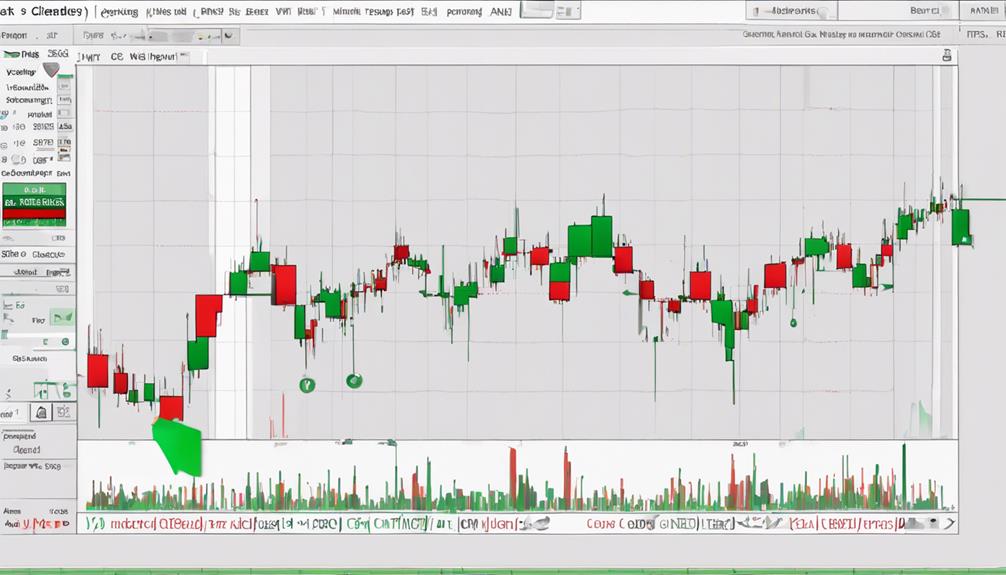
With a focus on Identifying Trend Direction With CCI, traders leverage the Commodity Channel Index to gauge market momentum and forecast potential shifts in price trends.
The CCI helps in determining trend direction by oscillating between specific levels, where crossing above +100 signals a bullish trend and dropping below -100 indicates a bearish trend. Trend direction confirmation is achieved when the CCI remains consistently above or below the zero line.
Moreover, CCI can provide early indications of trend direction by preceding price chart trendline breaks. Additionally, combining CCI with price action patterns enhances the accuracy of trend identification, allowing traders to make more informed decisions based on market dynamics.
Recognizing Overbought and Oversold Conditions
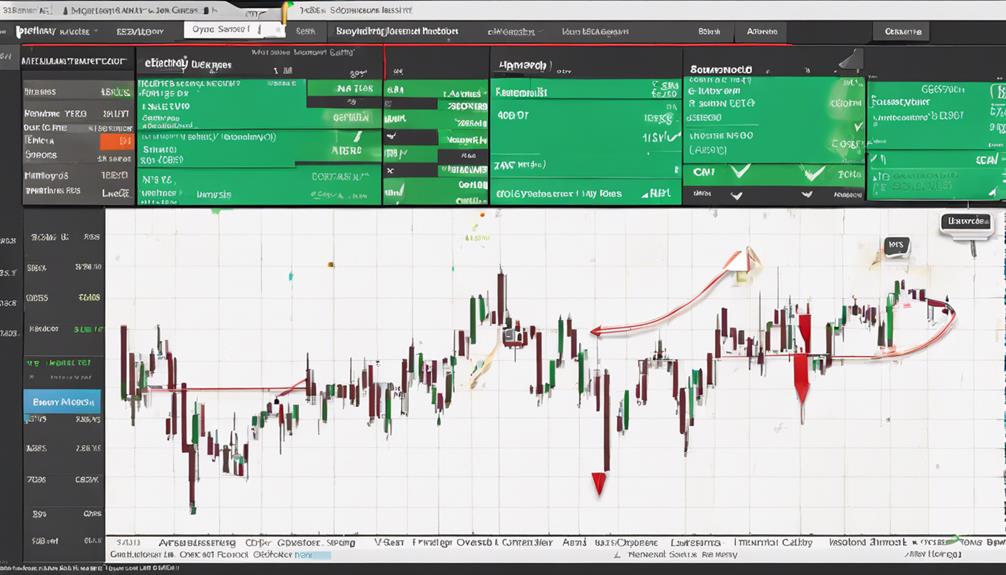
Overbought and oversold conditions in the Commodity Channel Index (CCI) are crucial for traders as they signal potential selling or buying opportunities respectively.
When the CCI rises above +100, it suggests overbought conditions, while falling below -100 indicates oversold conditions.
Extreme levels above +200 or below -200 denote exceptionally strong overbought or oversold situations that traders closely monitor for potential market reversals.
Overbought Signals
Amidst market fluctuations, recognizing overbought conditions through the Commodity Channel Index (CCI) plays a pivotal role in guiding traders towards potential reversal points. When CCI rises above 100, it indicates overbought conditions, potentially signaling upcoming price corrections.
Extreme CCI levels, like those surpassing 200 or 300 during strong downtrends, highlight highly overbought assets. Traders keenly observe any divergence between price movements and CCI to confirm overbought signals, aiding in more accurate analysis.
Identifying these overbought signals is crucial as they often precede price reversals, enabling traders to make timely decisions and avoid entering trades at unsustainable price levels. By understanding and interpreting CCI readings effectively, traders can enhance their strategies and navigate the markets more adeptly.
Oversold Indicators
Recognizing oversold conditions in the Commodity Channel Index (CCI) is crucial for traders seeking potential buying opportunities and market reversals.
- Oversold conditions in CCI occur when the CCI falls below -100, indicating potential buying opportunities.
- Traders look for extreme CCI readings below the -100 level to spot oversold signals.
- These oversold signals in CCI can serve as potential reversal points in the market.
- Confirmation from other technical indicators can enhance the validity of an oversold condition in CCI.
Understanding oversold CCI conditions enables traders to identify favorable prices to enter the market strategically. By leveraging these insights, traders can make informed decisions and potentially capitalize on market movements.
Interpreting Bullish and Bearish Divergence
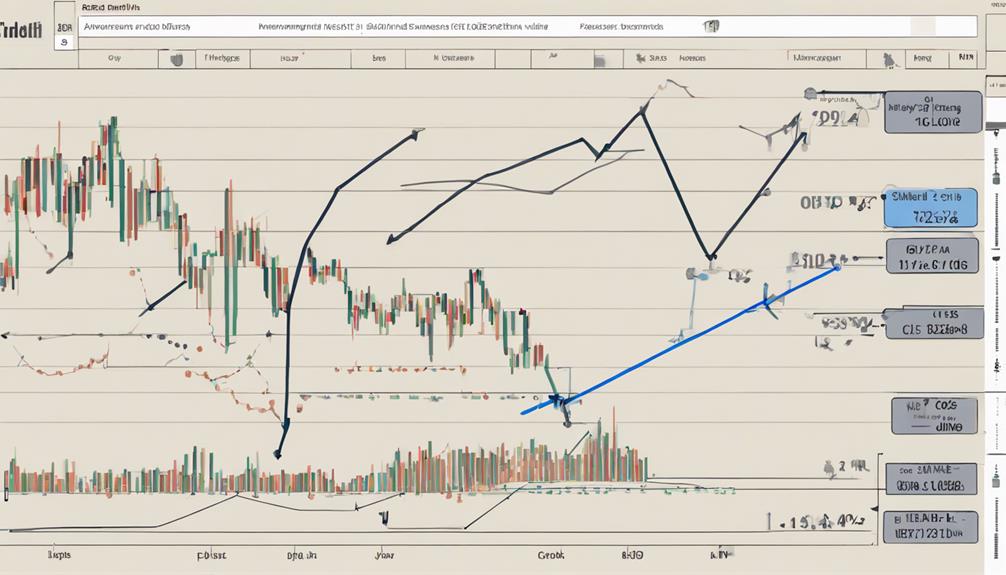
Bullish and bearish divergences in the Commodity Channel Index (CCI) provide crucial insights into potential trend reversals.
Bullish divergence, marked by lower price lows and higher CCI lows, signifies underlying strength and a possible upward price shift.
On the other hand, bearish divergence, characterized by higher price highs and lower CCI highs, warns of weakness and potential downward price movement.
Divergence Signals Trend Changes
In technical analysis, interpreting bullish and bearish divergence signals plays a crucial role in identifying potential trend changes in the market.
- Bullish divergence is indicated by lower lows in price alongside higher lows in the CCI indicator.
- Confirmation of bullish divergence occurs when CCI shifts upwards above the zero line, suggesting a potential trend reversal.
- Bearish divergence is characterized by price achieving higher highs while CCI displays lower highs, signaling a possible trend change.
- Confirm bearish divergence when CCI turns downwards below the zero line, supporting a potential shift in market direction.
Divergence signals, when combined with other indicators, can significantly enhance the reliability of predictions regarding trend changes.
Bullish Divergence Indicates Strength
The strength of a bullish divergence becomes evident when price trends lower while the Commodity Channel Index (CCI) displays higher lows, indicating a potential shift in market dynamics. This divergence suggests potential strength in the current uptrend.
Confirmation of bullish divergence is typically seen when the CCI turns upwards above the zero line. Traders often interpret this as a signal to look for buying opportunities as it may indicate a continuation of the uptrend.
When combined with other technical indicators, bullish divergence in CCI can be a powerful signal for traders to consider. Understanding these dynamics can enhance one's ability to identify potential shifts in market momentum and capitalize on favorable trading opportunities.
Bearish Divergence Warns Weakness
Interpreting bearish divergence involves identifying instances where the price achieves higher highs while the Commodity Channel Index (CCI) indicator registers lower highs, signaling a potential shift towards weakening momentum. Traders observe bearish divergence as a warning sign of a possible trend change or pullback, indicating weakness in the current upward movement. To effectively interpret bearish divergence:
- Price vs. CCI: Higher highs in price contrasted with lower highs in the CCI signal potential weakness.
- Weakening Momentum: Bearish divergence suggests a decrease in the strength of the current trend.
- Potential Reversal: It may indicate a potential reversal to the downside.
- Confirmation: Wait for the CCI to turn downwards below the zero line for confirmation of bearish divergence.
Combining bearish divergence signals with other technical indicators can enhance the decision-making process in trading.
Leveraging CCI for Momentum Strategies
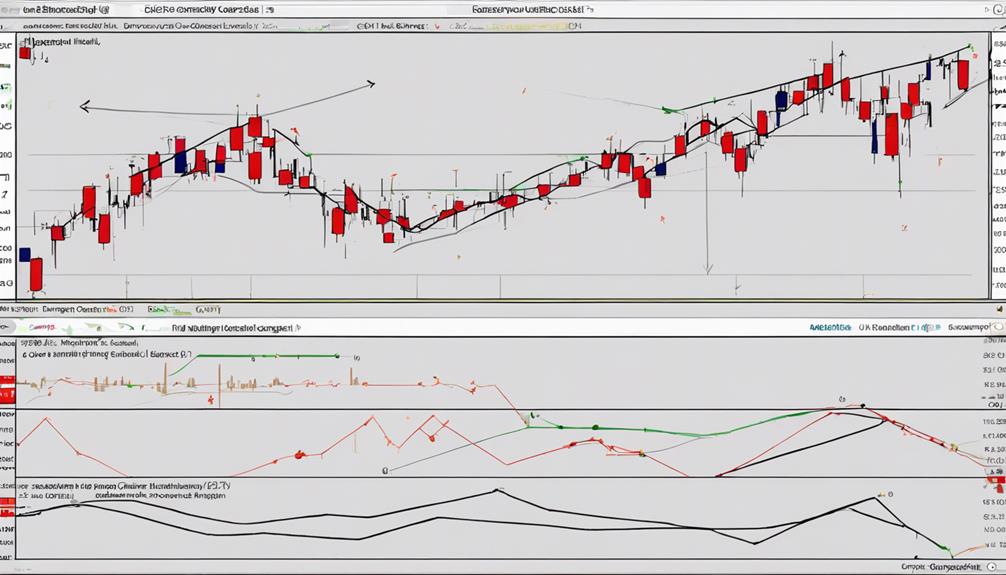
Utilizing the Commodity Channel Index (CCI) for Momentum Strategies involves strategically identifying and capitalizing on market momentum shifts driven by price deviations from a moving average.
Momentum traders leverage CCI to enter positions when the indicator reflects strong buying or selling pressure. This strategy aims to capture swift price movements by interpreting CCI readings above +100 or below -100, signaling overbought or oversold conditions.
To enhance the effectiveness of CCI-based momentum strategies, traders often combine this indicator with other momentum indicators such as the Moving Average Convergence Divergence (MACD) or the Relative Strength Index (RSI). By using CCI in conjunction with these additional tools, traders seek confirmation of trade signals, increasing the probability of successful trades.
Successful implementation of CCI momentum strategies requires prompt decision-making and timely execution to capitalize on momentum shifts in the market efficiently. By adhering to this approach, traders can potentially maximize their profits by riding the momentum waves indicated by the CCI.
Utilizing CCI Across Timeframes
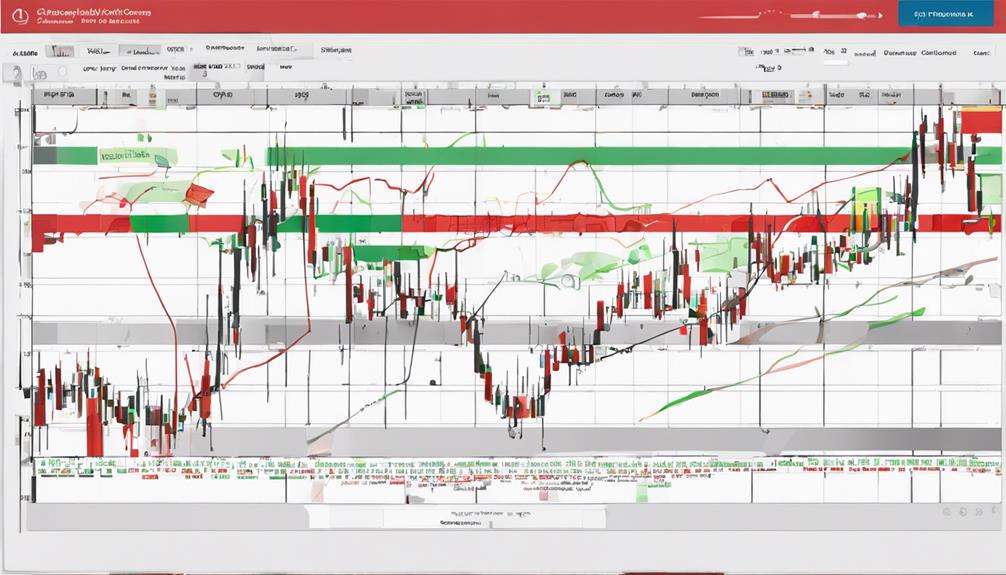
Building on the application of Commodity Channel Index (CCI) for Momentum Strategies, extending its use across various timeframes enhances traders' ability to navigate dynamic market conditions and optimize trading decisions. Analyzing CCI on different timeframes, such as daily, hourly, or minute charts, provides valuable insights into market trends and signals.
- Daily Charts:
Longer timeframes like daily charts help in identifying major trend changes and confirming signals from shorter timeframes, aiding in making informed trading decisions.
- Hourly Charts:
Hourly charts offer a balance between shorter and longer timeframes, providing a more detailed outlook on market movements and potential trading opportunities.
- Minute Charts:
Shorter timeframes like 5-minute charts are useful for quick trading opportunities based on CCI fluctuations, ideal for traders looking for rapid market entry and exit points.
- Trading Goals:
Adapting CCI strategies across various timeframes allows traders to align their approaches with different market conditions and trading goals, enhancing overall decision-making processes.
Enhancing CCI Effectiveness With Fundamentals
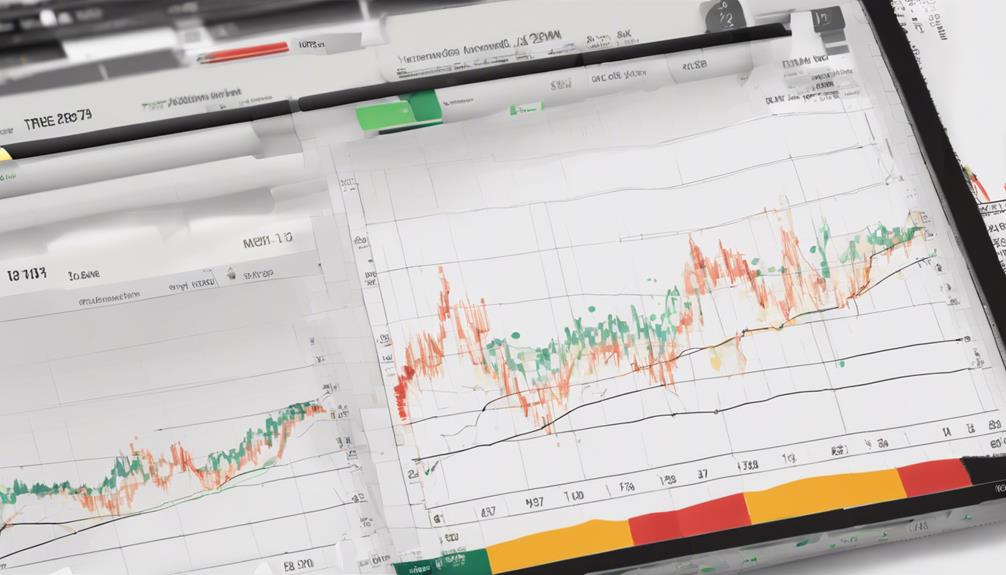
Enhancing the effectiveness of the Commodity Channel Index (CCI) through the integration of fundamental analysis provides traders with a holistic understanding of market dynamics and potential trading opportunities. Fundamental analysis delves into economic indicators, company financials, and industry trends, shedding light on factors that can influence CCI signals.
By considering fundamental aspects like interest rates, GDP growth, and geopolitical events alongside CCI readings, traders can better grasp market movements. Combining technical analysis with fundamental analysis allows for a more comprehensive view of market opportunities, enabling traders to make well-informed decisions.
Understanding how fundamental factors interact with technical indicators can enhance the accuracy of CCI signals, guiding traders towards more profitable trades. By incorporating fundamental analysis into CCI strategies, traders can navigate the markets with greater insight and agility, adapting to changing conditions and maximizing their trading potential.
Are the Steps to Effectively Read Commodity Channel Index the Same as Practical Steps to Navigate It?
Yes, the practical commodity channel index steps for effectively reading and navigating it are essentially the same. Understanding the CCI indicator, identifying overbought and oversold conditions, and using the appropriate time frame are crucial steps for both. Mastering these steps will help traders make informed decisions in the market.
Frequently Asked Questions
How Do You Read a Commodity Channel Index?
To read a Commodity Channel Index (CCI), traders analyze deviations from the average price to gauge overbought or oversold conditions. Crossing thresholds at +100 signals bullish trends, while drops below -100 indicate bearish trends. Understanding CCI levels is critical for accurate market interpretation.
How Do You Interpret the CCI Indicator?
The interpretation of the CCI indicator involves analyzing overbought and oversold conditions, trend strength, and price deviations from a moving average. Traders leverage CCI signals to identify potential buying and selling opportunities, enhancing decision-making in dynamic market environments.
What Is the Best Setting for the Commodity Channel Index?
The optimal setting for the Commodity Channel Index (CCI) is commonly a period of 14 for balanced sensitivity to price movements. Adjusting the period impacts signal frequency and accuracy. Experimentation with various periods aligns the CCI with trading strategies and market conditions.
What Is the Best Time Frame for a CCI Indicator?
The best time frame for a CCI indicator varies based on the trader's style and objectives. Short-term traders may opt for lower time frames like 5 or 15 minutes, while swing traders often prefer 1-hour or 4-hour charts. Long-term investors typically utilize daily or weekly time frames for trend identification and noise reduction.
Conclusion
In conclusion, mastering the art of reading the Commodity Channel Index can be the key to unlocking profitable trading opportunities across various markets.
By following the 7 steps outlined in this article, traders can effectively interpret CCI signals, identify trend directions, recognize overbought/oversold conditions, and leverage divergence for strategic decision-making.
With a data-driven and analytical approach, traders can enhance their trading performance and maximize profitability.
The potential for success in trading with CCI is truly limitless.
